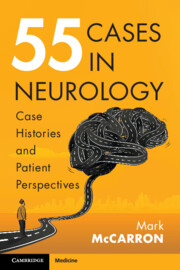Book contents
- 55 Cases in Neurology
- 55 Cases in Neurology
- Copyright page
- Contents
- Preface
- Acknowledgements
- Section 1 Visual Disturbance
- Section 2 Headache and Pain
- Section 3 Weakness
- Section 4 Behavioural and Language Changes
- Section 5 Confusion
- Section 6 Movement Disturbances
- Section 7 Acute Onset of Neurological Symptoms
- Case 46 A Neurological Miscarriage
- Case 47 Am I Repeating Myself?
- Case 48 A Raspberry Causing Trouble
- Case 49 Different Spells
- Case 50 Following the Eyes
- Case 51 Fuming Loss of Consciousness
- Case 52 From Skin to Brain
- Case 53 Self-Tolerance Failure
- Case 54 Not a Minor Problem
- Case 55 Seized
- Perspectives
- Index
- Plate Section (PDF Only)
- References
Case 53 - Self-Tolerance Failure
from Section 7 - Acute Onset of Neurological Symptoms
Published online by Cambridge University Press: 27 July 2023
- 55 Cases in Neurology
- 55 Cases in Neurology
- Copyright page
- Contents
- Preface
- Acknowledgements
- Section 1 Visual Disturbance
- Section 2 Headache and Pain
- Section 3 Weakness
- Section 4 Behavioural and Language Changes
- Section 5 Confusion
- Section 6 Movement Disturbances
- Section 7 Acute Onset of Neurological Symptoms
- Case 46 A Neurological Miscarriage
- Case 47 Am I Repeating Myself?
- Case 48 A Raspberry Causing Trouble
- Case 49 Different Spells
- Case 50 Following the Eyes
- Case 51 Fuming Loss of Consciousness
- Case 52 From Skin to Brain
- Case 53 Self-Tolerance Failure
- Case 54 Not a Minor Problem
- Case 55 Seized
- Perspectives
- Index
- Plate Section (PDF Only)
- References
Summary
A 34-year-old student nurse with a history of autoimmune polyendocrine syndrome type 1 with diabetes mellitus experienced stereotyped ‘bizzing’ sensations (not a noise) in her head with subsequent loss of consciousness. Within six months, four such events occurred. An eye-witnessed account suggested that she reached out to clutch or grab an object, her speech became confused and then she went rigid and blue. She frothed at the mouth with noisy respirations. There was twitching of her hands. The episodes typically lasted 90 seconds. She had bitten her tongue on two occasions but had not been incontinent. She was confused and disorientated for 90 minutes after the episodes. She had sustained at least one head injury as a consequence of the collapses. In two of the events, a blood glucose was recorded as normal. Corrected calcium was low at 1.94 mmol/L. She had some seizures when she was much younger, which were attributed to hypoglycaemia.
- Type
- Chapter
- Information
- 55 Cases in NeurologyCase Histories and Patient Perspectives, pp. 359 - 364Publisher: Cambridge University PressPrint publication year: 2023



